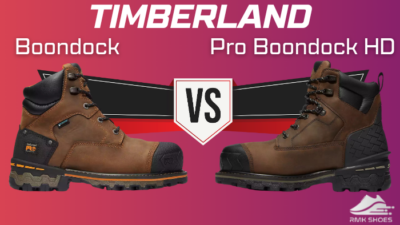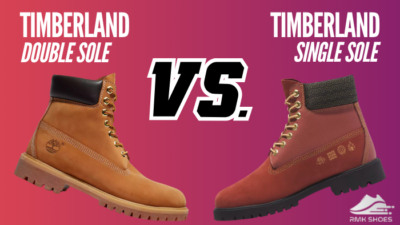Nobull and Metcon stand as fitness footwear giants, each boasting unique strengths.
Personally relying on Nobull’s Lifters and Trainer+ for weightlifting and versatile workouts, alongside my trusty pair of Metcon 8, I’ve made my way through the subtle differences.
That said, with their distinct personalities and strengths, choosing between the Nobull and Metcon can feel like a daunting quest.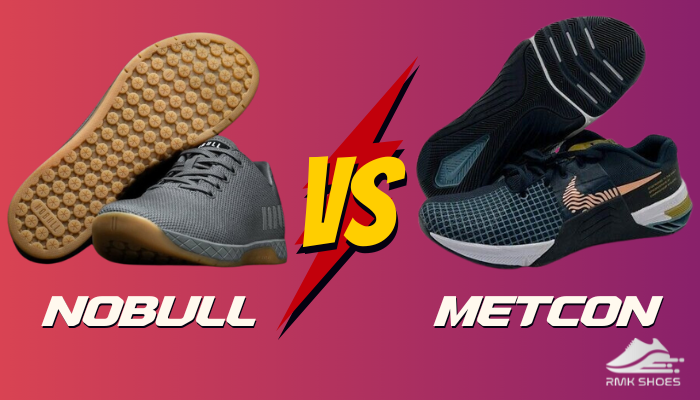
However, I have prepared the differences that I encounter between the Nobull and Metcon brands, which will help you pick the ideal one.
So, let’s begin.
Overview of Nobull and Metcon
Dedicated fitness shoes provide the support, stability, and protection needed for safe and effective workouts. They help prevent injuries, improve performance, and enhance comfort during exercise.
To address these needs, Nobull and Metcon were created.
Nobull was started in 2015 by Marcus Wilson and Michael Schaeffer. Nobull has won the hearts of CrossFit enthusiasts with its basic design, superior components, and direct-to-consumer sales.
Their vision was to offer athletes a better alternative to the bulky and over-designed shoes that dominated the market at the time.
Like Nobull, Metcon also launched in 2015. It’s a sub-brand of Nike dedicated to the CrossFit communities.
Leveraging Nike’s vast resources and expertise, Metcon quickly established itself as the go-to choice for athletes across various disciplines.
Metcon’s unwavering commitment to innovation and technological advancements has allowed it to consistently push the boundaries of athletic performance footwear.
With Nobull’s and Metcon’s long history and dedication, they have many CrossFit shoe models.
Let’s move on to the next section to review the core features of both brand products, and then we will discuss their offerings and characteristics in detail.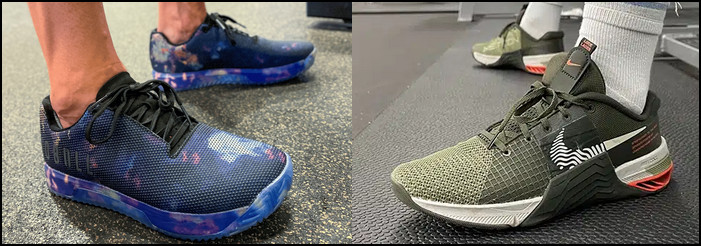
Feature Comparison Table between Nobull and Metcon
Nobull and Metcon stand out in athletic footwear for their dedication to performance and innovation. They offer some dedicated models just for your fitness club use.
While Nobull offers a wider variety of shoes to meet different needs, Metcon provides a few robust models. I have created a comparison table below with the distinctive differences you can expect from Nobull and Metcon.
Let’s see some key differences between the Nobull and Metcon:
| Attributes | Nobull | Metcon |
|---|---|---|
| Upper Material | SuperFabric / lightweight, and durable | Mesh material / breathable but less protective |
| Design | Minimal design | Athletic design |
| Breathability | Excellent | Average |
| Midsole | Compression-molded thin foam | Dual-density foam |
| Outsole | Rubber with SuperFlat technology | Rubber with sticky traction zones |
| Toebox Cushion | Provides more cushioning | Average cushioning |
| Durability | Highly durable | Moderate Durable |
| Support Level | High | Moderate |
| Price | 129 – 159 USD | 99 – 150 USD |
| Versatility | Extremely adaptable with a wide variety of shoe models. | Less versatile |
| Ideal for | CrossFit, weightlifting, high-intensity workouts | CrossFit, training, running |
These are some differences you can anticipate between the Nobull and Metcon shoes.
But there is still so much more. In the following section, I will address the differences based on my experience.
Differences You Need to Prioritize for the Nobull and Metcon
Nobull and Metcon Shoes are renowned companies for their dictation in the training community. They have achieved this status due to their commitment to excellence. They both have a wide range of shoes to meet your training needs.
Let’s now see the core differences between the Nobull and Metcon shoes:
1. Model Variety
Before discussing the qualities of the shoes of these two brands, let’s first see how many lineups they offer and how versatile they are.
Nobull
| Category | Model | Ideal Use Case |
|---|---|---|
| Trainer | Trainer, Trainer+ | CrossFit, weightlifting, high-intensity workouts |
| Rec Trainer | CrossFit, training, everyday wear | |
| Canvas Trainer | Everyday wear, light training | |
| Court Trainer | Training court use. | |
| Turf Trainer | Better for turf activities, stable | |
| Runner | Knit Runner | Running, training, long runs |
| Mesh Runner | Running, training, cardio exercises | |
| Ripstop Runner | Lightweight everyday running shoe | |
| Golf | GORE-TEX Ripstop Golf | Stable on a Golf field |
| Lifters | Leather Lifter | Weightlifting, Olympic lifting |
| Canvas Lifter | Weightlifting, powerlifting, CrossFit | |
| Slides | Offers comfort for daily use |
Metcon
| Category | Model | Ideal Use Case |
|---|---|---|
| The Strong One | Metcon 5 | CrossFit, training, running |
| The Fast One | Metcon Flyknit 3 | Running, fast-paced workouts, cardio exercises |
| Flexible One | Free x Metcon 2 | HIIT workouts, cardio exercises, training |
| Innovative | Metcon 8 | Responsive, breathable, and agile in your training session |
| Convenient | Metcon 9 EasyOn | Easy to put on, durable for athletic needs |
Though Nobull offers more models with the sheer variety and ability to cater to diverse training needs, Metcon offers better versatility.
However, I give Nobull the advantage for focusing on specific areas like CrossFit and weightlifting. Their minimalist design, SuperFlat outsole, and high-quality materials excel in these activities, offering exceptional stability and performance.
2. Design Philosophy and Construction
In the overall design department, you will quickly notice the variance with the bare eye. Also, it can be the first reason to pick the pair.
I love Nobull’s minimalist Converse-like style and focused approach.
Also, because of their plain upper design and variety of sole styles, they excel in CrossFit and weightlifting.
Now check the design and construction ideology of Nobull:
- Minimalist Design: Nobull prioritizes a minimalist approach, focusing on stability and responsiveness over excessive cushioning and support.
- SuperFlat Outsole: All the Nobull Trainers lineup offers super flat outsoles for stability, and some other models have more versatile outsoles.
- High-Quality Materials: Nobull utilizes durable and functional materials like SuperFebric, leather, canvas, knit, Eva foam, and rubber soles, ensuring long-lasting performance.
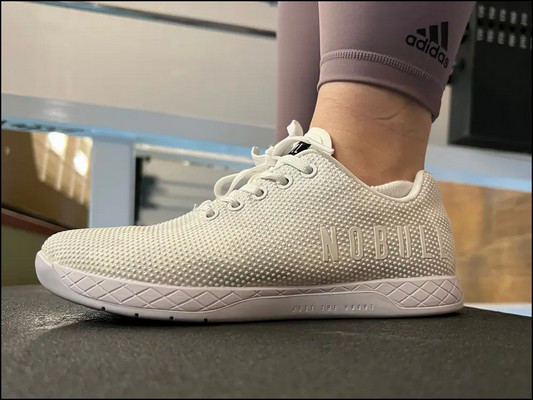
Meanwhile, Metcon has access to the company’s considerable R&D resources as a Nike subsidiary. It allows them to incorporate cutting-edge technologies and innovative designs into their footwear.
In my days of using the Metcon 8, it provided wow support in my renegade row and other intensive exercises.
Here are the design and construction convictions of Metcon:
- Varied Design Approach: Metcon uses a more varied design approach, offering models with different levels of cushioning, support, and flexibility. These help to cater to a broader range of training needs and preferences.
- Diverse Outsole Designs: Metcon offers various outsole styles, from traditional drop designs to a flatter style for stability.
- Wide Range of Materials: Metcon employs a broader range of materials, including synthetic leather, mesh, Flyknit, and React foam.
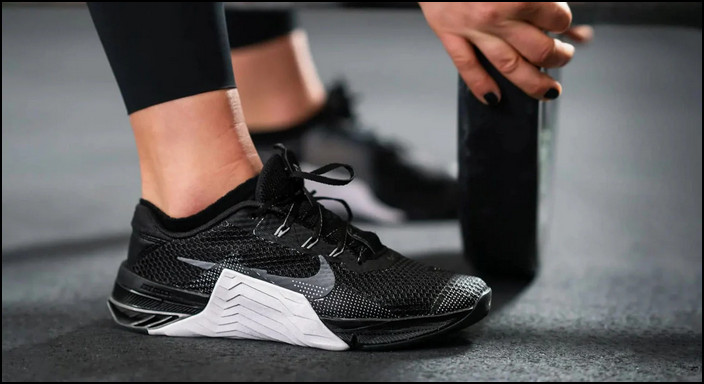 I prefer Metcon’s broader approach, catering to a more comprehensive range of training needs and preferences.
I prefer Metcon’s broader approach, catering to a more comprehensive range of training needs and preferences.
3. Upper Material and Breathability
Upper construction plays a vital role in training shoes cause I don’t like my feet to shut down from the outer world. It’s good that Nobull and Metcon keep that in their line of shoes.
Nobull offers various upper materials for its shoe models. They mostly use SuperFabric, Engineered mesh, knit, and canvas materials.
Most of these materials are long-lasting, but their breathability factor varies from model to model.
Nobull’s Trainer model provides a secure fit, but it feels like they are not highly breathable like their Runner models. Also, I use the Lifter just for my weightlifting, which uses a leather upper. But they have enough perforation holes to enhance breathability.
In contrast, Metcon also uses various materials for its upper assembly. The upper is mainly made of mesh and synthetic fabrics.
Metcon also has a lasting and durable upper with its mesh fabrics, designed to withstand the rigors of training. The mesh provides airflow and breathability, leaving your feet dry and cool even during intensive activities.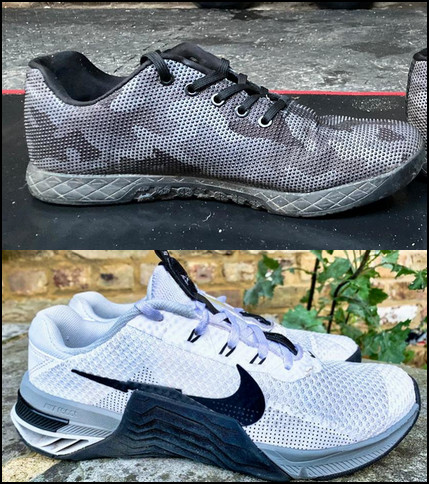
But, for the upper materials and breathability, the winner is Nobull. Their SuperFabric provides exceptional perforation where the foot needs it most.
4. Insole, Midsole, and Outsole
Nobull and Metcon have a variety of sole options to suit different needs. Now, take a closer look at each type of sole in a categorized section for easier comparison.
Insole
I’m quite picky about the insole cause most of my foot touches that part.
Nobull shoes originate from highly developed materials molded to a person’s foot shape. The firmness of the insole varies in their lineups, with Trainer+ models having thinner and firmer insoles while Runner models offer more cushioning.
The Nobulls are typically firmer, with a durometer of 41 on the ball of the foot and 42.4 on the heel.
Conversely, the insole in the Metcon is created from a lightweight foam that is both supportive and breathable.
I use a custom insole in my Metcon because the insole that comes with the shoe is too firm, with a durometer of 38.5 for the ball of the foot and 37.5 for the heel.
Midsole
The Nobull midsole originates from EVA foam. They also use the Pylon, a type of EVA foam with better cushioning properties.
Meanwhile, the midsole of Metcon is made with dual-density foam. They are great for cushioning and shock absorption.
Both of the brand’s midsoles are top-tier quality. They offer enough support, cushioning, and stability.
Outsole
Nobull features a proprietary SuperFlat outsole across all Trainers.
They primarily uses rubber for their outsole. This flat, wide outsole provides exceptional stability and traction, ideal for weightlifting and high-impact activities.
Nobull also has some softer, more aggressive curvature on their Runners model.
On the other hand, Metcon uses high-density rubber materials in its outsole. They offer a great experience in my energy-intensive exercise.
Also, the textured lug design on the outsoles of both brands provides excellent traction, so you don’t have to worry about slipping.
On my Nobull Trainer+, the lug pattern is extended to the shoe’s inside, making rope climbing easier.
However, Metcon takes it a step further by extending the Midsole around the lower vamp area and adding additional rubber materials beside the vamp.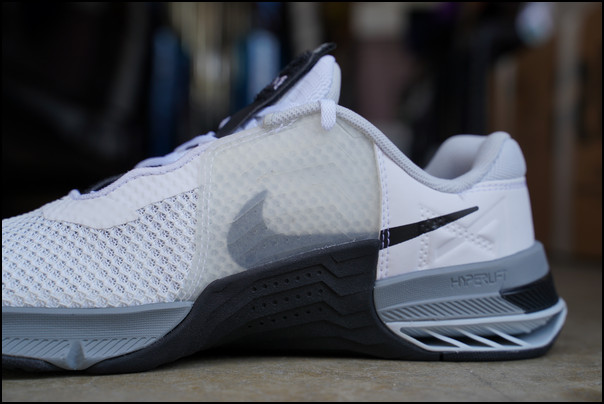
Nobull and Metcon have some incredible technologies built into their sole area.
Eventually, Nobull offers a better experience in my training session with its versatile sole.
5. Cushioning and Support
These characteristics are vital in athletic footwear, affecting comfort, shock absorption, and overall performance. Both Nobull and Metcon offer footwear with varying levels of cushioning to cater to diverse training needs.
Nobull generally prioritizes stability and responsiveness over excessive cushioning.
My Nobull Trainer+ model offers less cushioning, but it has superior stability.
But my friend uses their Runner model, which has enough cushioning while keeping the standard stability.
On the other spectrum, Metcon offers a broader range of cushioning levels depending on the model.
They use EVA foam and Zoom Air midsoles for moderate to high cushioning during activities like running and jumping while still providing responsiveness for CrossFit and weightlifting.
One thing I noticed in my activities with the Nobull and Metcon is that they are the same size, but Metcon seems more spacious on my foot.
The shoes provide ample room in the heel and toe box, but not in an uncomfortable way.
Nobull also provides a snuggly toe-box fit, and it has superior stability in my weightlifting training.
Overall, Nobull still wins my liking for the cushioning and stability.
6. Performance & Durability
Both Nobull and Metcon surpass in the performance and durability department. They offer high-performance footwear designed for athletes but differ in their approaches.
Nobull stands out in activities like weightlifting and CrossFit, where stability and responsiveness are crucial for optimal performance. Their 4mm heel-to-toe drop in the Trainers model offers excellent ground feel and balance.
Moreover, Nobull’s SuperFabric and canvas uppers provide excellent support and durability, ensuring long-lasting performance.
Metcon, on the other hand, caters to various activities, including CrossFit, weightlifting, running, and HIIT workouts.
Also, Metcon utilizes advanced technologies for a lightweight feel and react foam for responsive cushioning, which enhances performance.
Finally, Metcon is less durable than the Nobull lineups, but they perform better for various training purposes.
7. Community and Brand Identity
I saw many individuals wearing Nobull and Metcon shoes in my local gym.
Nobull emphasizes building a strong community through events, social media engagement, and athlete partnerships. They cultivate a passionate following among athletes who prioritize minimalist design and performance.
Meanwhile, Metcon benefits from Nike’s strong brand recognition and reputation in the athletic world, attracting a broader audience.
Both Nobull and Metcon provide a variety of models to accommodate various training techniques and preferences, resulting in a broader brand identity.
From my experience, these brands have a strong brand identity and recognition in the athletic world. Additionally, through their dedication, they gained great communal popularity.
Comparative Analysis of Nobull & Metcon: Pros and Cons
As you can see, Nobull and Metcone are genuinely dedicated to the athletic footwear community.
Nobull
- »Nobull promotes stability and responsiveness, ideal for weightlifting and high-impact activities.
- »Provides exceptional stability for various training exercises.
- »Utilizes durable materials like leather and canvas for longevity.
- »Offers competitive pricing and brand control.
- »Cultivates a passionate community through events and social media.
- »Not ideal for activities requiring significant shock absorption.
Metcon
- »Diverse options cater to various training needs and preferences.
- »Offers models with high stability or responsiveness.
- »Incorporates innovative technologies like Zoom Air for enhanced performance.
- »Leverages Nike’s reputation and heritage in the athletic world.
- »Suitable for CrossFit, weightlifting, running, and various other training activities.
- »Fewer options if you prioritize a minimalist approach.
Nobull Vs Metcon: Unveiling the Winning Shoe
Making the final call between Nobull and Metcon depends entirely on your preferences and training exercise.
Both brands produce high-quality footwear, but each excels in different areas. I have enjoyed using both of them during my training sessions.
Nobull shines in minimalist design and stability, perfect for weightlifting, CrossFit, and similar activities. Also, their wider fit and strong community resonate with individuals who value those aspects.
Metcon, on the other hand, excels in versatility with a diverse range of models catering to various activities.
Their innovative technologies and broader appeal attract athletes who seek options beyond a minimalist approach.
Ultimately, the best brand for you hinges on your individual needs and goals.
For example, I prefer the Nobull for my weightlifting training, but if you have to engage in more endurance or strength training, Metcon can be a great choice.
FAQs
What is unique about NOBULL?
Nobull is known for its minimalist design and stable footwear, ideal for weightlifting and CrossFit athletes who prioritize performance and stability. Nobull shoes are also very durable.
Are Nike Metcon shoes worth it?
Nike Metcon offers versatile footwear with diverse models catering to activities like running, HIIT, and agility drills. They leverage Nike’s established brand and utilize innovative technologies for enhanced performance. So, they are worth every penny.
Can you run in NOBULL trainers?
Although Nobull shoes can be used for running, but that’s not the ideal use for these shoes. Their stability-focused design makes them better suited for weightlifting and CrossFit.
Do NOBULL shoes run big or small?
Nobull sizing is generally true to size, but slight variations may exist across different models. For example, the Men’s Trainer 20 is slightly narrower than the Men’s Training Shoe, and the Women’s Trainer 20 is somewhat wider than the Women’s Training Shoe.

